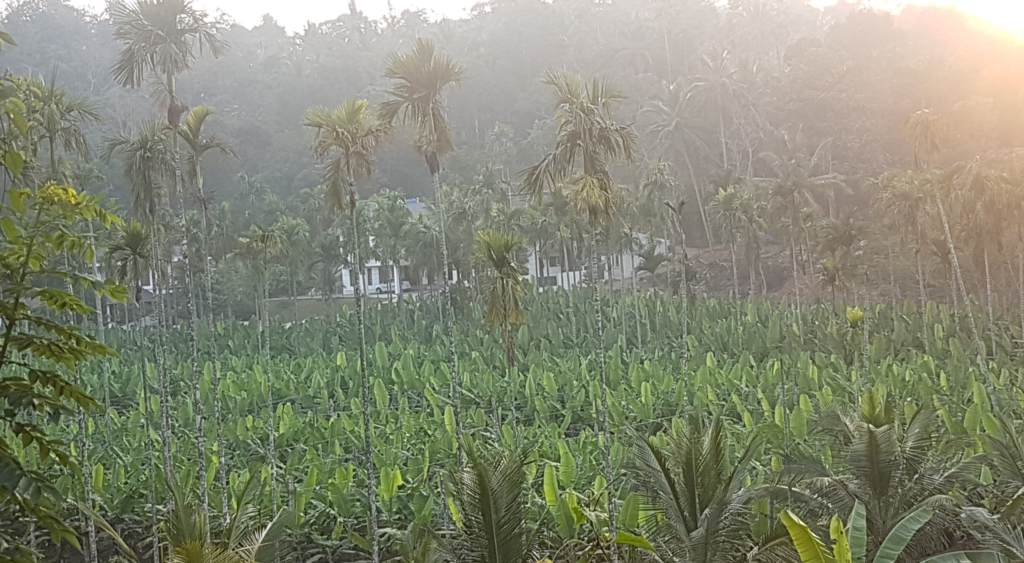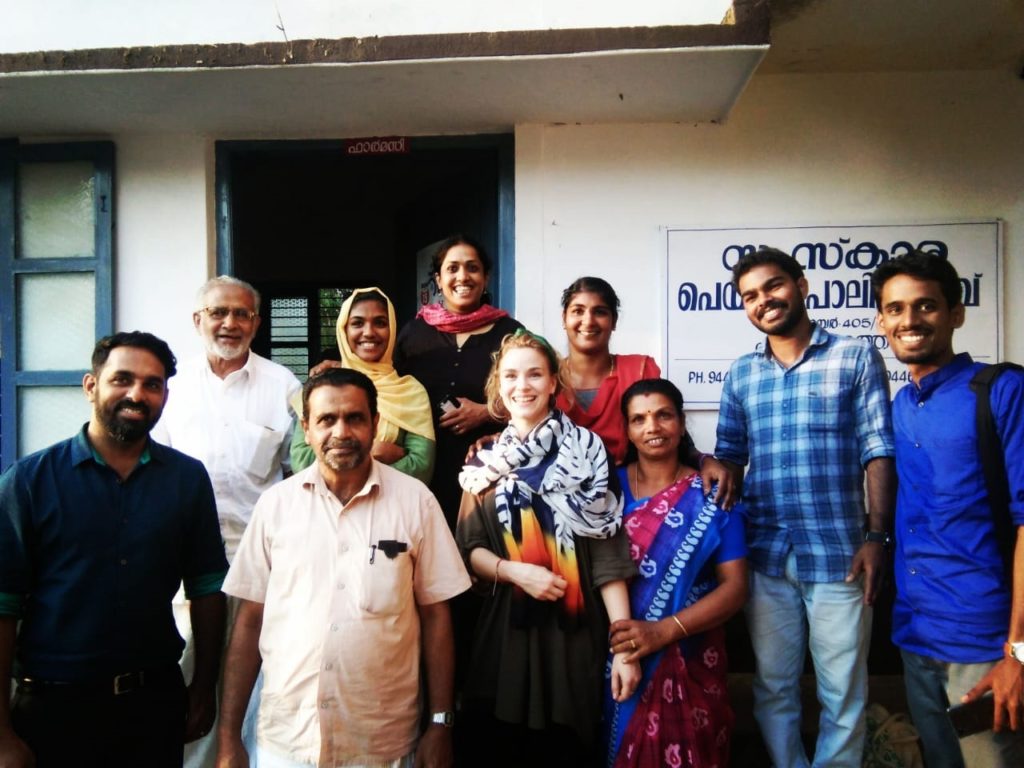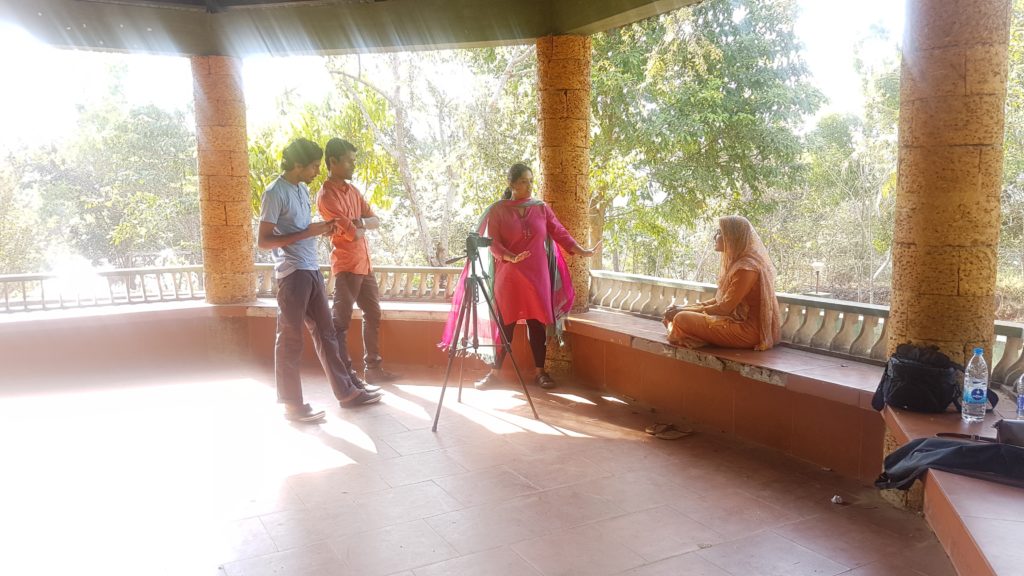
Recently, I had the privilege of going to India as part of our project “Creating a framework for assessing community based palliative care in Kerala” There, I was able to attend the Indian Association of Palliative Care’s annual conference and spend a week working alongside Dr. Devi Vijay from the Indian Institute of Management Calcutta, taking part in fieldwork and learning about the ‘scene’ of community palliative care first hand. It proved an immensely rewarding experience, both professionally and personally.
Since its beginnings in the 1990s, community based palliative care in Kerala, often referred to as the Kerala Model, has grown to achieve more than 60 percent palliative care coverage across this South Indian state. The number is all the more impressive in contrast with a mere 2 percent coverage nationwide. Initiatives to introduce community based palliative care (CBPC) in other parts of the country are ongoing, and drawing on inferences from Kerala, it is increasingly being taken up by actors in other countries, particularly across the Global South.
There is a growing sense in our part of the world as well, that there are lessons to be learned from community-centred end of life care, as David Clark has argued in a recent article in the Conversation. Developing a framework for evaluating CBPC in Kerala therefore has great potential.
Understanding what is crucial to the identity and functioning of CBPC as well as targeting what might be lacking, would serve to improve palliative care delivery in Kerala. This would in turn help facilitate a successful translation to other settings.
With all this in mind, I left for Kochi on the 6th of February. At the last minute, I was able to attend the Indian Association of Palliative Care’s annual conference, which took place in the hills outside the city. Here, delegates from across India as well as the rest of the world, braved the heat and assembled for a busy three-day programme. This was a great learning opportunity for me, and I got to hear prominent national and international speakers such as M. R. Rajagopal and Lukas Radbruch discuss the future and challenges of palliative care in India as well as globally and also to attend sessions on community involvement and volunteering.
The conference was also an introduction to some of the felt difficulties associated with developing nationwide palliative care in India. Indeed, as an American doctor mused during one of the breaks; it almost seemed like palliative care providers from other states go into the field with some measure of defeat, expecting that they will not succeed in the same way as in Kerala. Somehow, the notion that “there must be something in the water” which makes the Kerala model uniquely successful, seems to have seeped into the national discourse, colouring expectations nationwide.

Into the Field
After the conference, Dr Vijay and I left for Kozhikode, also known by the anglicised name of Calicut, on a morning commuter flight ultimately bound for Bahrain. Kozhikode would be our base for the next five days and upon arrival, I was instantly grateful for the slightly less humid climate. Indeed, wearing full-length trousers, long sleeved tops and scarves in 30-degree Celsius weather presents as a bit of a challenge to the system to a habitual Dumfries resident!
In Kozhikode, we headed to the Institute of Palliative Medicine (IPM), where we would meet the three field assistants. IPM is a collaborating institution in our project, and is located slightly outside the bustling and dusty city centre, on the premises of the city’s renowned medical college. It houses a small palliative care inpatient unit, as well as teaching facilities and offices and offers ample outside spaces in lovely green surroundings. The three field assistants, Prakash, Vishnu and Wafa, are all committed volunteers with IPM and they were invaluable contributors to the work. All three had a vast network of volunteers and patients with whom they coordinated visits and interviews, and their familiarity with the Kozhikode scene was a great way for us to gain legitimacy and to establish a rapport with our interviewees.
Over the next few days, we left the hotel in the morning only to return late in the evening. We visited several patient and volunteer homes in the city, and conducted interviews with nurses and physicians. In just five days, we accomplished approximately 20 interviews, lasting anywhere between one and two hours each. Most of the interviews were conducted in Malayalam, the official language of Kerala. My contribution in the field was thus mostly (and quite frustratingly!) limited to that of an onlooker, soaking in the atmosphere. However, Dr Vijay and the field assistants kindly translated parts of the interviews on-site, which permitted me to give my two cents and to chime in. In-between sessions, moreover, in the noisy auto-rickshaws taking us from one place to another, or in the evening after work, Dr Vijay and I would debrief and talk about the impressions of the day, continuously sharpening our research questions as well as coming up with new ones for interviews to come.
Our team also made a fieldtrip to Wayanad, a rural district up in the hills a few hours north-east of Kozhikode. Here, student volunteers had invited us to visit the local community clinic and a team of local volunteers took us on home visits with patients in their district. As we drove up the winding mountainous roads, stopping to take pictures of the view, passing beautiful tea plantations and lakes, it was easy to see why Wayanad is a popular tourist attraction. Its beauty however, stood in sharp contrast to the conditions in which some of our interviewees lived. Whereas the families we visited in Kozhikode were of different socio-economic status, during this fieldtrip in particular, we saw patients living in remote and destitute conditions. Indeed, for some, community palliative care was the only outside agency with which they had any regular contact. It was an eye-opening experience.
At times, the mind seems to ceaselessly fire in all directions. When the impressions are too many and too raw, it takes time to digest and sort through them in a structured way. I first experienced this during my PhD fieldwork in intensive care, where during the day, I would be restless, and where my nights were visited by relentless and cloudy dreams of patients and hospital beds. This was another such an occasion for me and I am left with new reflections and perspectives to bring into the project as we proceed.

Preliminary Reflections and Ideas Going Forward
Defining palliative care has proved challenging. Globally, several definitions exist, and as David Clark has argued, disagreements about how to define the field can sometimes be a source of controversy. In light of my visit to Kerala, I am increasingly convinced that in order for any good framework for evaluation to be possible, we first need to identify the obvious: what do we talk about when we say palliative care? In practice, I believe this means asking three questions: Who qualifies for palliative care? Why do they qualify? And what exactly do they receive?
When the palliative care movement originated in Kerala, it was primarily focussed on physical pain relief for cancer patients. This has to do with the historically severely restricted access to opioids for medical use in India, as well as, quite possibly, certain cultural attitudes toward pain, which caused pain management to be under-prioritized. Currently however, CPBC in Kerala includes a wide range of serious illnesses other than cancer, as well as non-life-threatening chronic conditions. Several of the patients we met during this visit suffered from chronic conditions that affected their mobility, as a result of stroke or spinal cord injuries. These injuries were sometimes a cause of great physical pain and in all cases left the patient more or less bedbound, which in turn provoked a host of associated problems, such as bedsores and infections and meant that they needed round the clock basic care.
I have come to see the Kerala model as implicitly embracing an understanding of palliative care that is focused not on life threatening conditions, yet which embraces the notion of life limiting ones in the broadest sense of the word. I here take a cue from another colleague in the project, Dr Jennifer Corns, who has written extensively about suffering, which she interprets as the disruption to a person’s agency (whether biological, social, mental or otherwise understood). Life limiting in this sense therefore, I suggest, refers to a person’s capacities for agency in the world and the associated suffering that follows from the disruption to it. This encourages a total or whole person and family centred care, as the agency-limiting aspects of the condition include both physical pain and symptoms, financial burden, carer burden (which in itself is multi-faceted), emotional, mental and spiritual distress as well as social isolation.
A staple of the Kerala model is that care is home-based. This has many practical and financial advantages (e.g. less need for in-patient facilities) and also responds to the public’s preferences. As in the UK, many people in India also prefer to face grave illness and end of life in their own home. In our preliminary interviews with patients, the fact that doctors gave home visits stood out as being extremely important. Many who live remotely would otherwise have to travel great distances to get to a clinic. The home based system however is also important in order to understand what palliative care provision practically entails. Indeed, my impression is that most patients will not have much contact with physicians or even nurses. In the outpatient clinics, it is often the next of kin who go, rather than the patient themselves. Physicians might make extra visits if called for, but for instance in the case of one family whom we saw in Wayanad, they will typically see a physician once a month and a nurse every two weeks. It is important to remember that when we say that there is a 60% coverage of palliative care, the carer activity remains mostly with the family.
In this model, the role of volunteers is absolutely crucial. Volunteers visit the patients and provide them and their families with emotional support, listening to their concerns, allowing them to share their worries and fears. This creates both an important emotional outlet and, for some, a vital opportunity for social connection as they may otherwise be quite isolated. Another essential part of the volunteers’ activities, which public or professionalised palliative care cannot so easily provide, is material support. Indeed, volunteers are in a position to ask the patient and family about their needs. Often, these are material as the majority of the population receiving palliative care is struggling financially. As one physician said in her interview, they have to work within their means. Oftentimes, she knows of treatments or dietary and hygienic measures that would greatly benefit the patient – but she does not bring them up, knowing that they are simply out of the realm of the possible for the family in question. “We cannot tell a patient to take two egg whites a day”, she said, “if we know they cannot afford to buy two eggs.” Indeed, the second element highlighted by patients is the fact that palliative care services are free –in contrast to other services. Many would otherwise not be able to afford pain medication. Receiving community based palliative care in Kerala therefore includes elements of financial support, as volunteers help fundraise to make improvements to patients’ homes, purchase equipment and even provide school clothes for children and food kits.
To my view, several of the patients whom we met during our brief week of fieldwork, if they were affluent, or indeed, if they lived in a country with a different healthcare system and greater material resources, would have lead very different lives. In some cases, I believe they would not have needed continuous palliative care services. Sometimes, palliative care works to alleviate the suffering caused not only by the nature of disease or injury itself, but by the gaps in a system whereby many individuals are left to suffer conditions that could otherwise be much improved through other areas of medicine or financial and social services, were they available. I believe that this material reality is key to creating a representative and fair framework for evaluation. Indeed, we cannot evaluate the success or quality of CBPC in Kerala (or indeed elsewhere) without acknowledging its activities as a reflection of the wider context in which it is situated – both culturally and materially.
A further complicating factor in investigating or evaluating the quality of palliative care, not least in light of this socio-material backdrop, is the issue of power. As a cultural, ethnic and linguistic outsider, I personally am not well positioned to evaluate this in the case of Kerala CBPC. Indeed, important notions such as that of privacy, social hierarchy and status, or the role of gender vary immensely between cultural settings. Consequently, I am mindful that many of the things that I find problematic might not be experienced as such by the local people – and vice versa.
Nevertheless, to my view, it seems inevitable that there is a particular power dynamic at play between a patient or family and the palliative care team when CBPC is in fact the only option available to the patient. If you cannot afford to purchase medication or to go elsewhere, the dependence upon the volunteer team is great.
Some patients and even their next of kin are confined to their homes. In these cases, the palliative care teams become their only outside contact and source of social connection. We must bear this fundamentally uneven relationship in mind when attempting to interrogate and to quantify the quality and the experiences of care. Moreover, as some of our interviewees reminded us; community based palliative care, like any other community movement, may often reproduce local or traditional power structures, customs and biases. Indeed, this was something that we observed during fieldwork (see also Vijay et al. 2018). Understanding the ways in which this happens will likely be crucial for evaluating the success of CBPC and for translating it to new areas.
Some Concluding Remarks
Over the course of my week in Kozhikode, I was taken aback by the hospitality and openness shown to us by both IPM, the Wayanad clinic, and more than anything, by the families and concerned individuals whom we visited. In any context, it is a great privilege to be granted access to private and vulnerable aspects of another person’s life, and they all graciously welcomed us into their homes where they shared their stories of illness, physical challenges and bereavement.
Moreover, it was truly inspiring to encounter both professionals and volunteers who dedicate their time to palliative care, many of whom go above and beyond in order to provide services to vulnerable patients and families. Like the two physicians who had taken up palliative care in addition to their regular work hours in the hospital, or Wafa, the project field assistant and long-time volunteer, who sends out group texts to ‘her’ patients on a regular basis, wishing them a good day, thus maintaining and cultivating a relationship with them even between visits.
For me, this short visit to Kerala helped bring the importance and relevance of our project into sharp relief. The Kerala model of palliative care is an undeniable success story. Even so, there is always room for improvement and a need to take the initiative further; alternatively, to understand how community based palliative care can improve upon the more recently initiated public provision. Moreover, with a mere 2% coverage across India, we need to understand well how the successful elements from Kerala might be translated and put to work in other places and to challenge the notion that there is “something in the water” in Kerala, which may create defeatist attitudes elsewhere. Dr. Vijay and the field team are currently continuing to conduct work across the state and I could not be more excited to be part of this important work. Look out for more posts as our Kerala evaluation project develops over the next few months.

